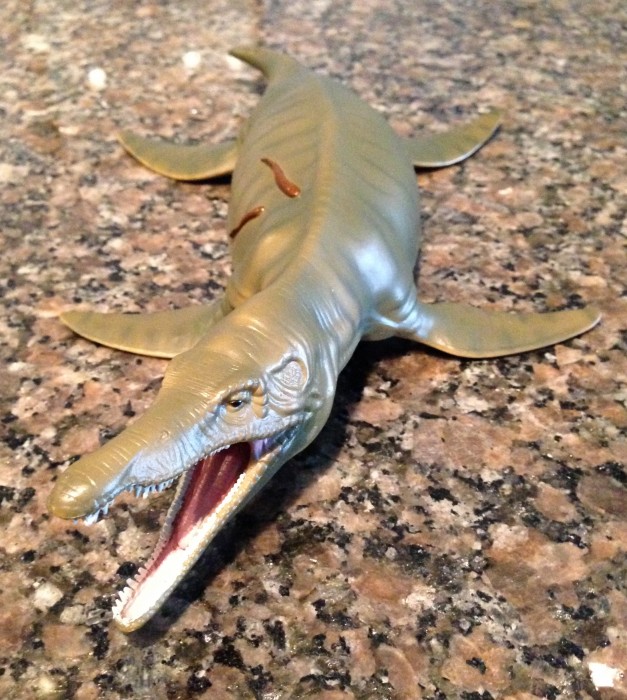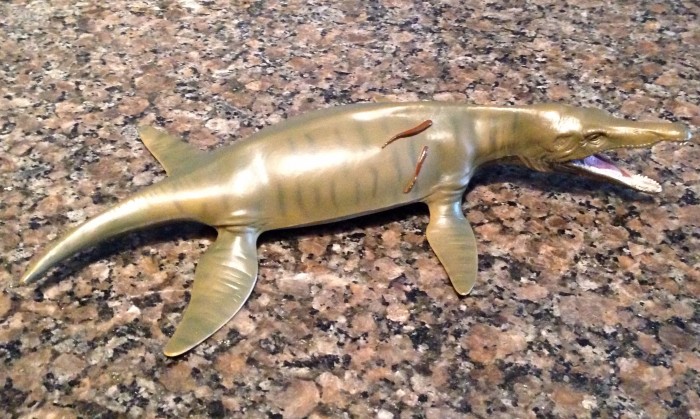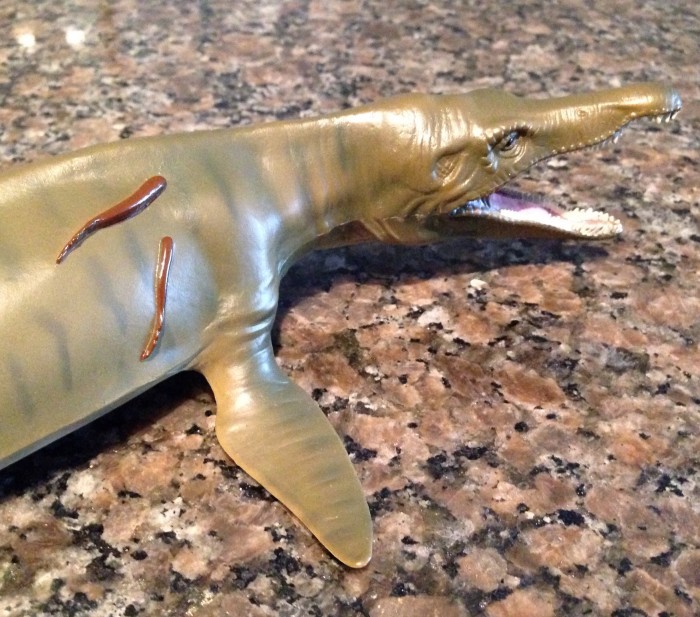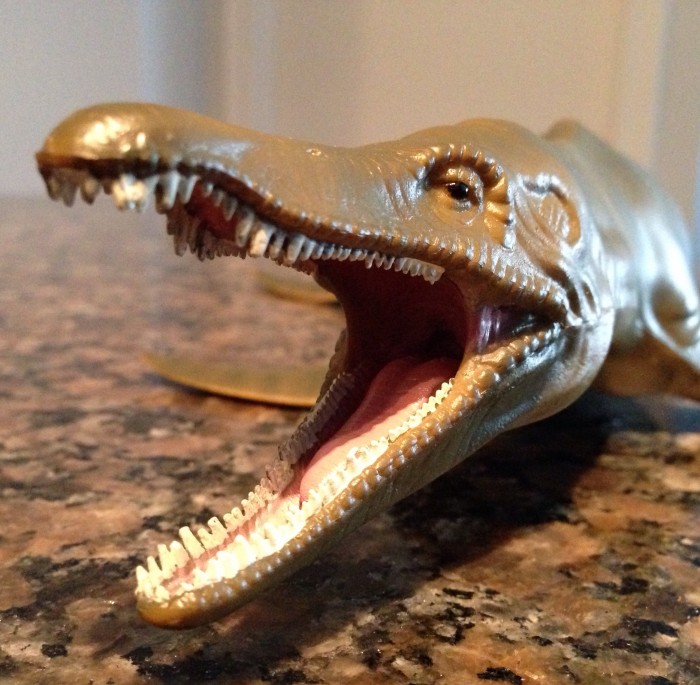Propelled by her four massive flippers, the leviathan explodes from the depths like a nightmare come to life. As she homes in on her target, her two-metre long head splits apart to reveal enormous pointed teeth. With decisive force, her jaws slam shut on . . . nothing. Her intended prey, an ichthyosaur, sensed the danger and bolted in the nick of time. The hunt has failed and the leviathan must start all over.
Millions of years before the evolution of mosasaurs, pliosaurs occupied the top of the oceanic food chain. And just as Mosasaurus was the mightiest mosasaur, the most powerful pliosaur was Pliosaurus itself. CollectA’s 2015 version of the “more lizard” measures a whopping 30 cm long, has a flipperspan of 16 cm, and weighs about one pound. This is a BIG toy, folks! Rightly so, given that it is based on Pliosaurus kevani, an gargantuan species represented by a nearly complete, two-metre long skull currently on display at the Dorset County Museum in Dorchester, UK.
The Pliosaurus is olive green in colour with a white underbelly, faint dark stripes, solid black eyes, dozens of pearly white teeth, and a pink mouth interior. It is sculpted in a turning pose with its mouth open, ready to clamp shut on anything it can catch.
Like most models of prehistoric sea monsters, the Pliosaurus‘ hide is mostly smooth, but it does have quite a few wrinkles on its head as well as on its muscular neck and flippers. The interior of the mouth is finely sculpted with multiple ridges and a big, long tongue. The teeth are also well-defined, although…
…accuracy-wise, there are a few subtle errors about this leviathan. The premaxilla(front of the upper jaw) is somewhat bulbous and downturned like a crocodile’s and the mandible is a little too straight. The teeth look formidable, but some of them could afford to be larger. The raised ridges around the eyes are unsupported by any underlying osteology. And finally, if we assume that the depression behind the eye is supposed to be an ear, it is in the wrong position. And if it’s simply meant to be the outline of a muscle, it’s too small. None of these are major enough to ruin the figure in my opinion though.
The Pliosaurus‘ great size and strength hasn’t prevented it from being assailed by parasites. Lampreys, to be precise. Three of the nasty little brown bloodsuckers, two on the back and one on the underside. Fear not though, they’re too small to cause any serious harm to such a huge animal. Indeed, they may simply be hitching a ride. Lamprey fossils date all the way back to the Devonian, so it’s quite possible that they latched on to pliosaurs back in the Jurassic. This is a clever, realistic touch on the part of CollectA.
With its monstrous size, fearsome appearance, and fine attention to detail, the CollectA Pliosaurus promises to be one of the best prehistoric toys of 2015, even if it does have its share of inaccuracies. It’s definitely one of my favourites now.
Special thanks to paleontologist Adam “Plesiosauria” S. Smith for his expertise on pliosaur anatomy.
Disclaimer: links to Ebay and Amazon on the DinoToyBlog are affiliate links, so we make a small commission if you use them. Thanks for supporting us!










I thought the lampreys were just scratches
[…] for 2017. And with a length of 31 cm and a flipperspan of 18.5 cm, this briny brute topples the Pliosaurus for the title of their biggest sea monster to date. It is sculpted in a swimming pose with its huge […]
The head on the CollectA Pliosaurus didn’t look right to me from the moment I first saw it. I’m not surprised to see it’s inaccurate.
This figure’s head is horrendous. The relatively smooth skin on most of this figure looks possible. But then the head is all wrinkly and there are what look like lumps all around its eyes and mouth and even on its eyelids. This just looks ugly and implausible to me. Why would an animal that needs to be as streamlined and efficient as possible have these features on its head? I wonder if prehistoric marine reptile toys with skin that isn’t on the smooth side are like that because perhaps some think more detail is better? I’ve always really liked the smooth skin on the Invicta Liopleurodon, Ichthyosaurus and plesiosaur since I had them as a kid.
When I look at this figure’s tail it really looks like it’s missing a tail fin. If it had a good head (and no parasites attached) I certainly would’ve liked this figure more. As it is, I don’t like it at all.
I’ve updated the review to include a number of subtle anatomical errors pointed out by Plesiosauria. 🙂
If you think about it, those lampreys must be gargantuan!
About 1 metre long.
Yes, I wouldn’t want to see a lamprey that size swimming towards me.
As a coauthor of the paper that described Pliosaurus kevani (http://journals.plos.org/plosone/article?id=10.1371/journal.pone.0065989) I can tell you that there are inaccuracies in this model, especially in the head – my review would be far less favourable!
I’d be very interested to hear about these inaccuracies. Please share and I’ll see about amending the review.
I am also interested in a real and objective review about the product. I’m not well versed in these matters, but I wonder, why this figure is wrong.
I think the figure errors have learned in the future.
I would love to get your professional take on this figure. For me, it is a quantum leap above the Carnegie Kronosaurus which it replaced on the “extinct sea creature ledge” in my living room.
I took another hard look at the head after reading the above and noticed that this baby has a HUGE over-bite, which I suspect was not there in the living creature, and I always question fenestrae visible through the skin. A peak at your article also showed photos of a fossil with teeth jutting outward at perhaps a 45 degree angle while all of those in the model are perfectly vertical.
Cheers,
PLB
For me one of the best marine reptiles made by Collecta and in general for all factories Dinosaur Toy, moreover the actual figure is better than the prototype of photography.